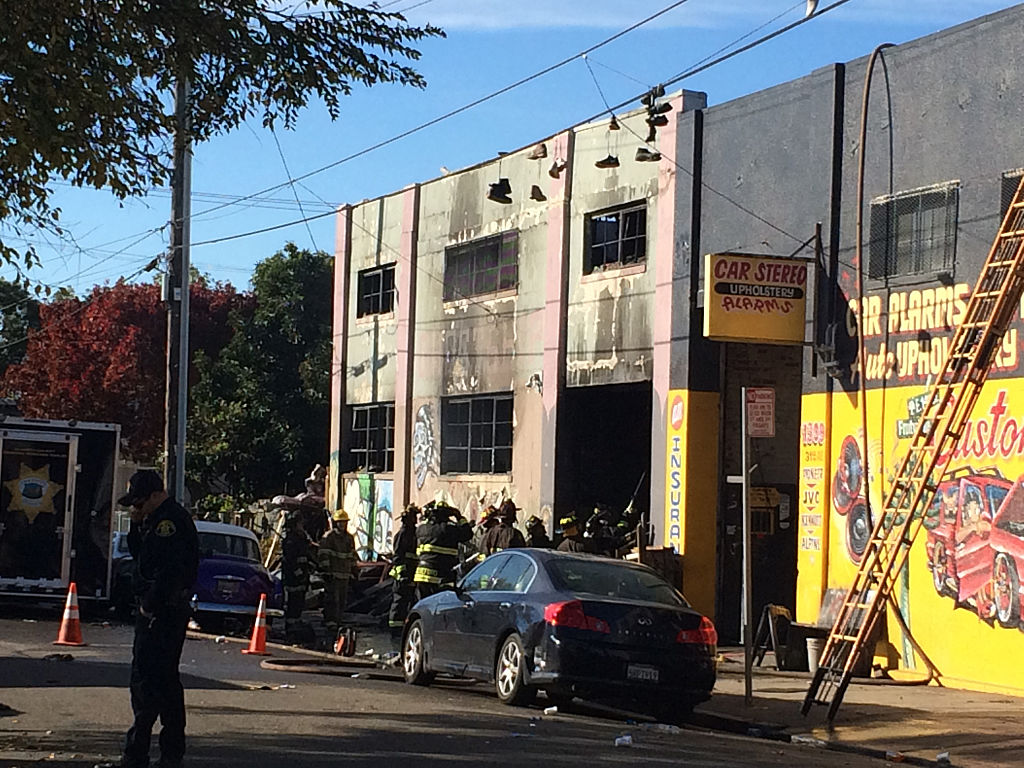
A warehouse in Oakland, California, known as Ghost Ship and which hosted underground music events and acted as a hub for a local artist community, caught fire on Friday night, December 2. As the death toll continues to rise, fire officials are calling it one of the deadliest fires in Oakland’s history.
As of Sunday afternoon, 33 people were confirmed dead, reports the Huffington Post. Most victims were in their 20s or 30s, but at least one was as young as 17.
The source of the deadly blaze, which started between 11 and 11:30pm, is unclear. A small crowd had gathered for an event thrown by record label 100% Silk. Performers had not yet begun, but an estimated 60 people were already present, reports the alternative newspaper East Bay Express.
The event took place on a second floor inside the warehouse, which was only accessible via one staircase, an unstable construction made of wooden pallets. The warehouse has been described by witnesses as maze-like, stuffed with furniture, objects, and artworks. Matt Hummel, who had previously visited the Ghost Ship, told the East Bay Times that the staircase was “a really scary way to get up and down… like climbing a fort.” The setup blocked the easy escape of those inside.
The tragedy is a huge blow to the community of artists, musicians, promoters, and fans who considered the warehouse—despite its lack of sprinklers or working fire extinguishers, and makeshift architecture—a safe space from the intolerance and bigotry experienced in some mainstream venues, that can be just as dangerous to marginalized members of the community. Among the missing persons are transgender people and people of color.
Singer-songwriter Kimya Dawson outlined in a Facebook post on Saturday the reasons why artists may gravitate to physically unsafe spaces.
“I have played in so many spaces with precarious floors and beams and stairs and not enough exits and certainly no sprinklers,” writes Dawson. “[W]e take the risks. Playing and listening in unsafe spaces. Because when we feel like we are dying anyway the risks don’t seem as risky as the risks we already face every day… If I hadn’t had people inviting me to their unconventional venues over the years I would have been dead a long long time ago… We’re not trying to put each other in danger.”
The East Bay Express spoke to Oakland party promoter and record label owner Nihar Bhatt and musician Russell Butler, who both pointed to rising rent costs in the area as the ultimate problem at hand, averting blame away from the music community. Although the building was not sanctioned for residential use, a number of artists lived in Ghost Ship.
A memorial near the site of a warehouse fire that has claimed the lives of at least 33 people in Oakland, California. Photo Elijah Nouvelage/Getty Images.
The need for fire safety measures is now being emphasized by artists across the country. A widely-shared Facebook post by Philadelphia architect Melissa J. Frost calls for the creation of a guide to building safety for DIY venues. Others are sharing the link to a relief fund for victims.
Some community members had reportedly voiced concern about the safety of the venue in the past but, as Bhatt told the Express, “I think they bit their tongues because we desperately need places to gather.”
“We need spaces that are open to folks who are beaten down and oppressed by living daily under patriarchy and white supremacy,” Butler added.
Fire safety officials continue to search the building, but the efforts are made difficult by a collapsed roof. Meanwhile, a community mourns.